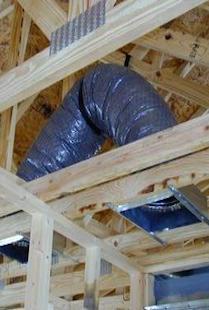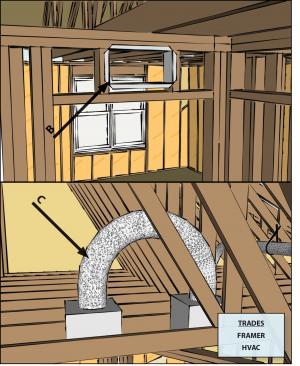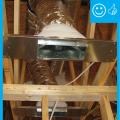Scope
Provide for pressure balancing between bedrooms and the rest of the house, using jump ducts or another means. Jump ducts are also commonly referred to as jumper ducts or crossover ducts.
- Install ducted returns or a combination of ducted returns, transfer grilles, jump ducts, and/or door undercuts in bedrooms to allow pressure balancing between bedrooms and the rest of the house in homes with ducted heating and cooling systems by providing a path for room air to return to central air handler thereby increasing the volume of conditioned air circulating in the room.
- ENERGY STAR Single-Family New Homes requires that the dedicated return ducts, transfer grilles, jump ducts, and/or door undercuts together achieve a rater-measured pressure differential of ≥ -3 Pascals and ≤ +3 Pascals (0.012 inch water column) with respect to the main body of the house when bedroom doors are closed and the air handler is operating on the highest design fan speed. A rater-measured pressure differential of ≥ -5 Pascals and ≤ +5 Pascals (0.020 inch water column) is acceptable for rooms with a design airflow ≥150 cfm.
- If transfer grilles or jump ducts are used, refer to the balancing report provided by the HVAC contractor for the bedroom air flows to size the grilles or ducts. If a balancing report was not provided, the flow of the supply register when the air handler is on high speed may need to be measured using a flow hood, anemometer, or other flow measurement tool. Ensure that both openings have the required free area. Seal all seams, gaps, and holes in the ducts and connections.
- Test the pressure differential with the bedroom doors closed.
See the Compliance Tab for links to related codes and standards and voluntary federal energy-efficiency program requirements.
Description
For central “forced air” furnace and air conditioning systems to operate properly, the HVAC distribution system should be designed with adequate supply and return registers to provide conditioned air to all parts of the house and return stale air to the furnace for reconditioning. Inadequate return air pathways can cause pressure imbalances from room to room, which can cause drafts and temperature differences between rooms or floors, leading to comfort complaints. Pressure imbalances can also cause the furnace and air conditioning equipment to work harder than necessary. A well-designed return air strategy is critical for the performance of the HVAC system in an energy-efficient house, which may have lower airflow requirements to meet the lower heating and cooling loads (Burdick 2011). The return air must have a clear path back to the air handler from every room that has a supply outlet, with the exception of bathrooms or kitchens due to the potential for spreading odors through the house (Burdick 2011).
Most forced air systems use central return registers consisting of one more centrally located return registers that are ducted to the return side of the air handler. To provide a pathway for air from rooms with closed doors to these central return registers, builders can use door undercuts or install transfer grilles or jump ducts. A jump duct is a short piece of insulated flex duct (typically 10-inch-diameter duct) installed in the attic and attached to ceiling registers in the closed room and a common space to provide a return air pathway between the two areas. A transfer grille is a grille or register installed in the wall or above the door to connect the closed room with an open space such as a hallway or living room, thereby providing an additional pathway for stale air to reach the centrally located return.
Jump ducts may be installed by the HVAC installer. This task should be included in the contract for the appropriate trade depending on the workflow at specific job sites.
How to Install a Jump Duct
- Before ceiling drywall is installed, determine a location between the ceiling rafters in each room. Install the registers and insulated flex duct.
- After ceiling drywall is installed, seal the registers to the ceiling drywall with caulk. Seal the duct to the register boots with mastic or plastic or metal ties and approved metal tape, not duct tape.


Success
To determine if an adequate ducted return was installed, the following room-to-room pressure measurement can be used:
- Turn on the air handler to high.
- Close all interior doors.
- Using a manometer, connect tubing to the input port. The reference port for the differential pressure measurement can remain open.
- While standing in the center of the house or hallway, place the tubing from the manometer under each door and record the pressure difference from each room with respect to the main body of the house (note the presence of a negative or positive sign). The bedroom will typically be pressurized (positive) when the doors are closed.
- ENERGY STAR requires that rooms should not be pressurized or depressurized by more than 3 Pascals for any room being supplied with less than 150 cfm of conditioned air. If the supplied airflow to a room exceeds 150 cfm, a threshold of ±5 Pascals is required. These are good metrics to strive for regardless of whether or not pursuing ENERGY STAR certification.
Climate
No climate specific information applies.
Training
Compliance
Retrofit
SCOPE
Install jump ducts to address pressure differences in an existing home.
- Test pressure differences between rooms as part of an energy assessment or in response to complaints about uneven temperatures or drafts.
- Inspect for adequate return pathways to the central air handler (central return duct and air pathways to the central return from isolated rooms [i.e., bedroom and office rooms with doors that are often shut]). Return pathways can be provided by individual return ducts, transfer grilles, jump ducts, or door undercuts.
- Install ducted returns or other return pathways as needed.
DESCRIPTION
In existing homes, homeowners may sometimes experience strong drafts or large temperature differences between rooms or central forced air systems that seemed to be noisier or working harder than they need to. One cause of these problems could be pressure differences between rooms, especially when doors are closed, caused by inadequate return air pathways to allow stale air to flow freely back to the return side of the HVAC air handler so it can be heated or cooled for distribution back through the house. Pressure testing as part of a whole-house energy assessment can determine whether the house is pressures are unbalanced. For more information on pressure balancing, see the guide Pressure Balancing Supply and Return Ducts in Existing Homes.
There are several methods that can be used to provide return pathways from isolated rooms to the central return grille; these include individual return ducts, transfer grilles, jump ducts, or door undercuts.
In existing homes, the instructions for installing jump ducts are the same as those for installation in new construction; see the Description tab. Access to the attic is required. While it is not desirable to locate ducts in unconditioned spaces (e.g., a vented attic), there may not be another option. In this case, insulate the jump duct to or above new code requirements to minimize the negative impacts of heat loss or heat gain to unconditioned space.
Once you have determined the location of the jump duct, remove attic insulation from these areas to provide a clean working surface. Transfer the dimensions of the registers to the top side of the ceiling drywall. Cut the openings, install the registers, and seal the registers to the drywall using an appropriate air sealing sealant. Connect the insulated flex duct to the duct boots at each of the registers with mechanical fasteners and seal the joints with mastic or approved metal tape as described on the Description tab. Support the flex duct, making sure not to kink the air pathway. Re-apply the attic insulation.
If cutting through painted surfaces, check for lead paint and mitigate as required. If cutting through plaster and wood lath ceilings, additional care will be required to minimize crumbling of the plaster. High-speed cutting tools, such as powered multi-tools or an angle grinder with a diamond blade, can assist in making clean cuts through the plaster and lath (but will create a considerable amount of dust, so you may want to have a vacuum operating next to the tool while cutting. Another trick is to apply a sealing compound to the attic side of the lath to harden it up (minimize flex) prior to cutting.
When doing work in an existing home, refer to the following Building America Solution Center guides for safety guidelines:
- Pre-Retrofit Assessment of Attics, Ceilings, and Roofs
- Pre-Retrofit Assessment of Hazardous Materials
Also see the U.S. Department of Energy's Standard Work Specifications guidance for general worker safety.
COMPLIANCE
See Compliance tab.
More
More Info.
Access to some references may require purchase from the publisher. While we continually update our database, links may have changed since posting. Please contact our webmaster if you find broken links.
The following authors and organizations contributed to the content in this Guide.
Building Science Corporation, lead for the Building Science Consortium (BSC) and Steven Winter Associates, Inc., lead for the Consortium for Advanced Residential Buildings (CARB), both DOE Building America Research Teams,
and the Pacific Northwest National Laboratory.
Sales
Jump Ducts = Comfort Crossover Vent

Air needs to flow from the central heating and cooling comfort system to living spaces and back again. Comfort crossover vents allow air to flow from each bedroom to the central return ducts, often located in hallways. The vents are typically built into the ceiling on either side of the adjoining wall. They are connected using insulated flexible ducts.



